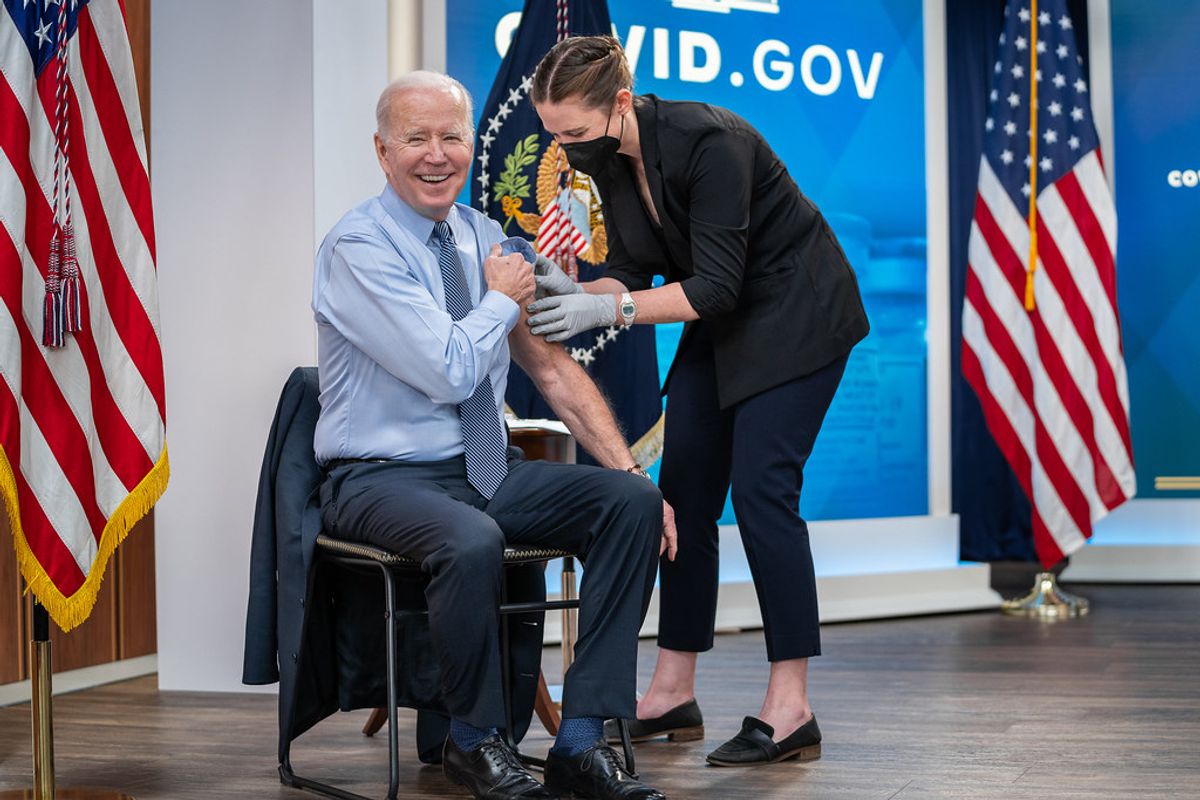ABOVE: © ISTOCK.COM, LAKSHMIPRASAD S
As yet another wave of increased COVID-19 cases, hospitalizations, and deaths rolls on, this one fueled by the newer Omicron subvariants BA.4 and especially BA.5, public health authorities are largely eschewing earlier measures such as mask mandates, stay-at-home orders, improvements to ventilation in buildings, and even continuing to track the disease, instead relying heavily on repeated doses of mRNA vaccines.
Indeed, while some low-income countries still haven’t been able to deliver primary vaccinations to high-priority individuals such as healthcare workers, roughly a dozen countries have rolled out a second booster—that is, a fourth dose—of the mRNA vaccines developed by Moderna or Pfizer/BioNTech to at-risk groups, including older people. Preliminary data from those countries has shown that this second booster is highly effective at preventing severe illness and death among those groups.
See “To Booster or Not: Scientists and Regulators Debate”
But questions remain about how and the extent to which the second booster fortifies the immune system against the coronavirus, how long benefits last, and how well a strategy centered around recurrent inoculations will work, especially among less vulnerable groups. That’s led to some debate as to whether otherwise-healthy people should hold off until new vaccines designed to protect against Omicron subvariants are available, likely in October, in lieu of getting a fourth dose of the same vaccine sooner. For instance, the US Food and Drug Administration (FDA) recently confirmed to NPR that it plans to change course, fast-tracking Omicron-specific boosters instead of lifting age restrictions on a fourth dose of the original vaccines, in part because of concerns of “vaccine fatigue” the public might experience as a result of back-to-back booster campaigns. In contrast, Israel has made the shots available to all adult citizens.

The Scientist spoke with several experts who have studied the coronavirus vaccines from medical, pharmaceutical development, and public health perspectives about the science behind the second booster shots, who would benefit, and how to develop personal and public health strategies for vaccination going forward.
How the fourth dose boosts the immune system
Preliminary data indicate that a second booster temporarily increases the quantity of antibodies that attack SARS-CoV-2’s spike protein beyond levels reached by prior doses.
“The second booster clearly enhances the antibody response when compared to the first booster,” says Prakash Nagarkatti, a senior research advisor to the president at University of South Carolina School of Medicine Columbia, adding that doing so helps the vaccine course’s protective effect last longer than they otherwise would have.
See “Booster Is Best in the Same Limb as Initial Vaccine: Mouse Study”
For example, recent studies in The New England Journal of Medicine and The Lancet Infectious Diseases found that the second booster quantitatively performed well, with participants’ antibody titers peaking higher after a fourth dose of an mRNA vaccine than they did after the third. And in the latter study, more pronounced antibody increases were observed in participants 70 years of age or older—an age group especially at risk for severe disease. However, the researchers in The Lancet Infectious Diseases study note that for some participants, the benefits of the fourth shot were limited because the immunity boost conferred by the third hadn’t yet waned. This phenomenon, referred to by the authors as a “ceiling effect,” may mean that a second booster offers little to no additional protection in certain people or populations.
What’s less clear is whether it goes beyond a temporary jolt of protection to enhance the body’s immune response to the virus long term. Such qualitative gains were documented for the third shot: For instance, in preprint research posted to bioRxiv in May, head of vaccine research and development at GlaxoSmithKline Rino Rappuoli and colleagues found that receiving a third shot not only increased the quantity of antibodies produced, it also enhanced the breadth of the immune response to the coronavirus by introducing new classes of B cell germlines not present after the primary two doses. This increased breadth, Rappuoli says, is why the booster enhances protection against newer variants. But none of the experts who spoke with The Scientist say they’ve encountered any evidence suggesting a further broadening of the immune response after dose four.
See “What You Should Know About New Omicron Subvariants”
This makes sense to virologist Helen Bright, who argues that repeatedly injecting people with the same vaccine will repeatedly yield the same result. “Every time you do a boost, you’re re-presenting that same spike antigen . . . you might get some breadth [in the immune response], but you’re boosting that same dominant response,” says Bright, the former director of virology biopharma R&D at AstraZeneca who recently became the head of infection biology at Medicines Discovery Catapult in the UK. She also suggests the possibility that what appears to be a broadened response after the first booster is actually B cells that were present after the primary vaccinations finally reaching the threshold of detection.
If you’re in a high-risk group . . . anything you can do to get neutralizing antibody levels up is a good thing.
—Helen Bright, Medicines Discovery Catapult
Meanwhile, experts say they know less about the impact that the fourth vaccine dose has on other immune cells, such as T cells, because the necessary research hasn’t yet been conducted. One potential concern is that repeated boosters could lead to T cell exhaustion—a phenomenon where excessive exposure to an antigen (like the SARS-CoV-2 spike protein) conversely reduces the response T cells have to it over time. So far, there’s no evidence that a fourth shot leads to this exhaustion. In The Lancet Infectious Diseases study, for instance, the participants’ T cells responded to the fourth shot at least as strongly or even more so than they did to the third. Although, like with antibody titers, there were some participants whose cellular responses remained elevated after the third shot. Therefore, the additional booster appeared to have little if any effect on their T cells. Also, the authors cautioned that their T cell analyses are limited by small sample sizes—much more data from diverse populations is sorely needed.
How effective is a second COVID-19 booster?
Most of the data published to date on the fourth dose come from epidemiological studies in countries that have started administering it to the elderly. The timing of these rollouts makes it difficult to compare the protective effects of subsequent boosters across variants of SARS-CoV-2, explains Jeff Kwong, a public health researcher at the University of Toronto. While data have shown again and again that the various Omicron subvariants evade both vaccine-induced and natural immunity better than earlier versions of the coronavirus, “No one brought in a second booster before Omicron came,” he says. “So you can’t really look at it against anything else.”
“There are all these studies out there, and they’re all done . . . under separate circumstances, and that’s what makes it challenging,” Kwong adds. “You have to look at all the different aspects that go into the results. In general, I think [vaccine effectiveness] is lower against Omicron and it’s almost like having the third dose is like having two doses before Omicron [because] the virus has evolved.”
Second Booster Dose's Protection Against Infection |
 A second booster significantly protected residents of long-term care facilities from infection. ADAPTED FROM FIGURE 2 OF MUHSEN ET AL., JAMA INT MED, 182:859–67, 2022 |
Still, despite differences among countries’ vaccination programs and studies’ protocols and outcome measures, trends have emerged: Studies have found that a second booster leads to a marked reduction in severe disease outcomes and death from COVID-19 in at-risk populations, but a lesser reduction in the number of overall infections than speculative projections for how the vaccine would have fared against pre-Omicron variants.
One such study, comparing outcomes of 24,088 twice-boosted volunteers residing in long-term care facilities in Israel against 19,687 who only had one booster, found that the second booster conferred just 34 percent better protection against infections than the first—24.9 percent of once-boosted participants got infected during the study compared to just 17.6 percent of those with two boosters. The second booster also granted 64 percent better protection against hospitalizations, 67 percent better protection against severe illness, and 72 percent better protection against death from COVID-19, although the overall numbers of people with those outcomes was very low, even in the group with just one booster. A similar study by Kwong and colleagues on more than 61,000 long-term care facility residents in Ontario found that the second booster provided 31 percent more protection against symptomatic illness and 40 percent more protection against severe illness beyond that provided by the first booster.
A more generalized, retrospective cohort study on the effectiveness of the second booster among 60-plus-year-olds in Israel found nearly a four-fifths reduction in deaths among those who were boosted twice compared to those who were only boosted once. Data from the US Centers for Disease Control and Prevention (CDC) are similar, suggesting people at least 50 years of age with just one booster had four times the risk of death from COVID-19 of those with two boosters.
Ronen Arbel, a health outcomes researcher at Sapir Academic College in Israel who coauthored the study that found the four-fifths reduction, tells The Scientist over email that the point of the second booster is to “avoid severe outcomes,” and therefore he celebrates the fourth vaccine dose’s protective benefits as a success, even if its protection against mild infections is imperfect.
See “Moderna vs. Pfizer: Is There a ‘Best’ mRNA Vaccine?”
Experts who spoke with The Scientist say they expect the second booster’s benefits to be less pronounced in younger, healthier populations, in part because those groups are more likely to retain the benefits of a first booster for longer.
For example, an observational study published August 2 in JAMA Open Network measured disease outcomes among once- and twice-boosted healthcare workers in Israel, who averaged 44 years of age. The second booster didn’t reduce the rate of severe or fatal cases of COVID-19 over the first, because neither group had any such cases. There was a notable drop in infections, with 20 percent (4,802 of 24,280) of once-boosted and just 7 percent (368 of 5,331) of twice-boosted participants testing positive during the study.
The duration of protection against infection offered by the fourth dose also remains unclear—it’s simply too soon to tell, especially as more Omicron subvariants emerge, experts say. However, Kwong notes that vaccine effectiveness wanes over time in general, as some of the protection conferred by the shots comes from temporary immune responses such as high circulating antibody levels. “So any boost in immunity the fourth dose offers beyond that of the third is likely temporary.”
See “CDC: COVID-19 Booster Effectiveness Wanes After Four Months”
Rappuoli expects, based on his career in vaccine development, that the effects of the fourth dose wane sooner than those of the third. “The fourth dose will basically protect people for a very short period of time, and then people will become susceptible again to infection. Not to severe disease—[for] severe disease, you’re very protected by the third dose.”
Should everyone get a second booster?
In May, the World Health Organization (WHO) announced that it recommends that everyone who is able to gets a first booster dose “based on evidence that doing so would have substantial impact on reducing hospitalization, severe disease and death, and to protect health systems.” The WHO only recommended a second booster for the immunocompromised, noting that “[d]ata on the usefulness of these additional booster doses is sparse and especially limited on the duration of further protection.”
Experts who spoke with The Scientist broadly echoed the WHO’s guidelines, saying that the elderly or people who are chronically ill or immunocompromised ought to get vaccinated and double boosted to protect themselves as best they can.
“Clearly the vulnerable population, including those that are immunocompromised and those whose lifestyle makes them easier targets of COVID, should not wait till [Omicron boosters roll out this] fall, because the current vaccines will provide them some level of protection,” says Nagarkatti, who recently wrote about the choice between a second booster or waiting for an Omicron-specific booster in The Conversation.
Cumulative Hazard Ratios (HR) for Death Due to COVID-19 by Booster Status |
 Twice-boosted 60- to 100-year-olds had a lower risk of death from COVID-19, based on comparative hazard ratios, which measure the risk of death in a given group. ADAPTED FROM FIGURE 2 OF ARBEL ET AL. NAT MED, 28:1486–90, 2022 |
“If you’re in a high-risk group . . . anything you can do to get neutralizing antibody levels up is a good thing,” says Bright.
As for people that aren’t in high-risk groups, the experts say there’s no real reason that those who are younger, relatively healthy, and already have received a first booster should avoid getting the second booster, but it’s also not as crucial for them as for more vulnerable populations. However, Nagarkatti suggests that such groups ought to consider getting an Omicron-specific booster regardless of whether they get the fourth dose.
Kwong says that COVID-19 booster shots “might become like our annual flu shots,” though he expects guidelines and age cutoffs to continue to differ among various countries and regions “based on their local epidemiology and their population.”
However, these researchers suggest that it would be a mistake for governments and public health agencies to continue relying on vaccine boosters as their main intervention.
“It’s not sustainable to plan a vaccination regime where you have to give one dose every two or three months to prevent infection,” Rappuoli says. “In the general population, I’d say, it’s not a solution”—although subsequent boosters would be better than nothing for immunocompromised people. “The solution for the general population is [to deploy] vaccines against new variations, against Omicron. That would be not the fourth dose, but the first vaccination against that.”
Bright agrees. “They’re keeping the same spike sequence” in vaccines, she notes, meaning that a second booster “was the fourth time our B cells have seen that. . . . What we want is something a bit more diverse now.”
Omicron-specific boosters, some of which also contain the immune-stimulating components of the original vaccines in addition to Omicron-specific antigens, are likely on their way, pending successful clinical tests. Most of the researchers The Scientist spoke with agree, and preliminary data suggest, that Omicron boosters will offer better protection than the original vaccines against the SARS-CoV-2 variants presently dominating the globe. Therefore, they say, it’s likely that these boosters can make a real dent in infection rates, which in the US still number in the thousands every day.
See “How the Omicron Subvariant BA.5 Became a Master of Disguise—and What It Means for the Current COVID-19 Surge”
“Clearly the data show that the bivalent vaccines which incorporate the Omicron variant provide stronger and better protection against the Omicron variants,” says Nagarkatti. “Thus, it is clearly better to get vaccinated with such newer vaccines than the original vaccines because Omicron is the primary strain that is spreading.” However, he adds, things may change if a new variant takes over.
See “Opinion: Dismantling Anti-vaccine Rhetoric on Social Media”
Rather than trying to develop vaccines at the pace of an ever-changing virus, reintegrating or continuing other public safety measures—such as masking, isolating and distancing, providing financial support, and improving indoor ventilation—would probably make a bigger difference to the general public than distributing a fourth, fifth, or sixth booster shot. Changing our attitudes and everyday behavior and not treating vaccines as a silver bullet, Bright says, would likely save lives—and not just by cutting down on SARS-CoV-2 transmission.
“The one thing COVID has done is made us realize and appreciate that respiratory infections are not a good thing for the elderly and at-risk populations, and maybe we should think about our behaviors whenever we have a respiratory infection,” she says. “Maybe we should think about wearing masks, not going into work.”
The disappearance of the flu (presumably thanks to COVID-19 control measures) led Bright to reflect on how odd it was that society allowed such a deadly disease to spread rampantly for so long, she adds. “As a virologist, it would be nice to see people wearing masks on the Tube [the subway in Britain]. It would be nice if, when you had a cold, that you got on the Tube, you wore a mask, or didn’t even get on the Tube; you stayed home. You never know who’s vulnerable, who might be next to you, who might catch flu from you.”






